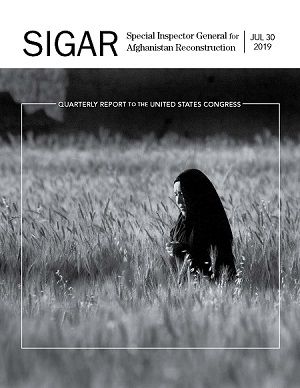Afghanistan
MacArthur, Eisenhower, and the Lost Lessons of Building Partnership Capacity
- Read more about MacArthur, Eisenhower, and the Lost Lessons of Building Partnership Capacity
- 1 comment
About the Author(s)
Counterterrorism After a Peace Deal in Afghanistan
About the Author(s)
SIGAR's 44th Quarterly Report to Congress
SIGAR's 44th Quarterly Report to Congress

On Thursday, the Special Inspector General for Afghanistan Reconstruction (SIGAR) released its forty-fourth Quarterly Report to Congress.
Key Points
-- For the fourth consecutive quarter, ANDSF strength is reported at the lowest level since the Resolute Support mission began in January 2015. This quarter's ANDSF strength decreased by 41,777 personnel since approximately the same period in 2018. According to CSTC-A, the decline was due to ANDSF switching their reporting of personnel strength to the number enrolled in the Afghan Personnel and Pay System (APPS) rather than the number reported on-hand by ANDSF components.
-- This quarter's ANDSF assigned strength is 77.4% (79,535 personnel short of its authorized strength), a nearly 10 percentage-point decline from last quarter.
-- Resolute Support reported 6,445 enemy-initiated attacks (EIA) this quarter (March 1 - May 31), a 9% increase from the preceding three months (December 1, 2018 - February 28), but a 10% decrease from the same period last year.
-- Of the 6,445 EIA reported this quarter, roughly 43% were "effective" enemy-initiated attacks (EEIA) that resulted in ANDSF, Coalition, or civilian casualties. This is a 17% increase compared to the preceding three months (December 1, 2018 - February 28), but a 7% decrease compared to the same period last year.
-- ACLED, the Armed Conflict Location & Event Data Project, reported a 66% increase in incidents in Afghanistan this quarter (March 1 - May 31) compared to the same period in 2018. These incidents include violent and nonviolent activity of all parties to the conflict. Violent activity made up 98% of recorded incidents.
-- Resolute Support reported this quarter that casualty rates for the ANDSF are the same as they were in the same quarter one year ago.
-- SIGAR analysis of Afghan government education enrollment data confirms that no girls were enrolled in grade 12 in 85% of districts in Helmand Province in 2018.
-- Girls' education lags across much of southern Afghanistan. All seven provinces where no females were enrolled in at least 50% of districts were located in Afghanistan's South or Southeast regions. Nearly 2.6 million girls are out of school in Afghanistan, according to the Afghan government.
-- The United Nations Children's Fund (UNICEF) reported that the number of attacks against schools in Afghanistan tripled in 2018 - to 192, up from 68 in 2017. The report also noted more than 1,000 Afghan schools were closed at the end of 2018 due to ongoing conflict and approximately 500,000 children "were denied their right to education." High levels of school closures continued in 2019.
-- According to CSTC-A, the Afghan Ministry of Interior's Criminal Investigative Directorate (MOI CID) has undertaken no investigations or other actions to counter corruption. CSTC-A stated their belief that MOI CID leadership participates in, rather than disrupts, corruption.
-- The Afghan government recovers less than 1% (0.2%) of financial penalties issued by the Anti-Corruption Justice Center (ACJC) and struggles to execute warrants and summonses.
-- In cases involving prominent figures, the UN says the Afghan criminal justice system "looks like a system promoting impunity." According to the UN, there are numerous incidents when the police failed to make arrests and the AGO failed to issue charges. Further, suspects have been released prior to trial and orders to not leave the country were not enforced.
-- According to data from the Department of Defense, nine ANDSF personnel went absent without leave (AWOL) while in the United States between January 1 and July 1. Thirty-nine ANDSF personnel went AWOL in the United States between January and December 2018.
Full Report: https://www.sigar.mil/pdf/quar
Quarterly Report by Section: https://www.sigar.mil/quarterl
